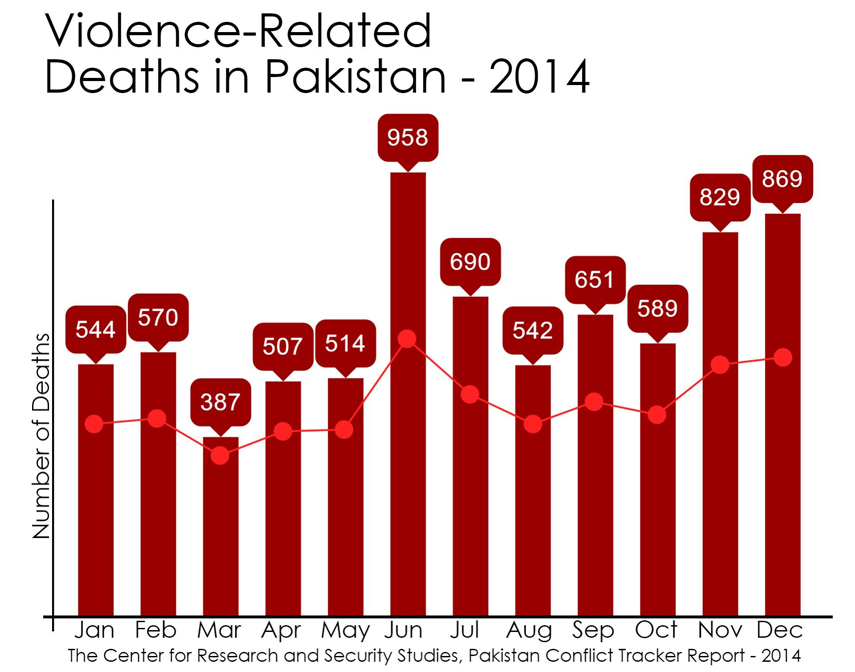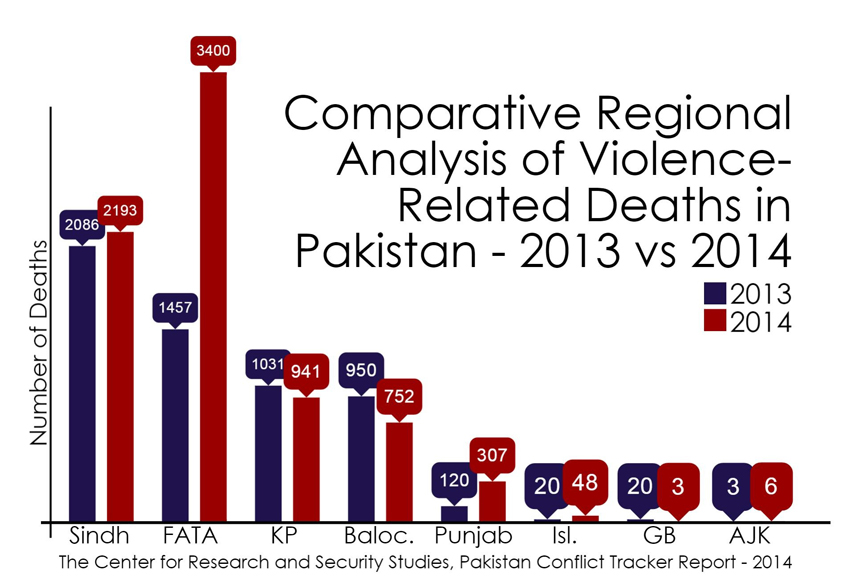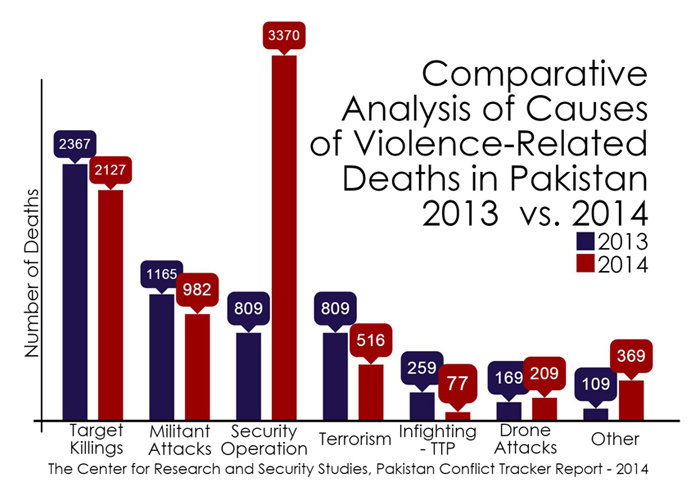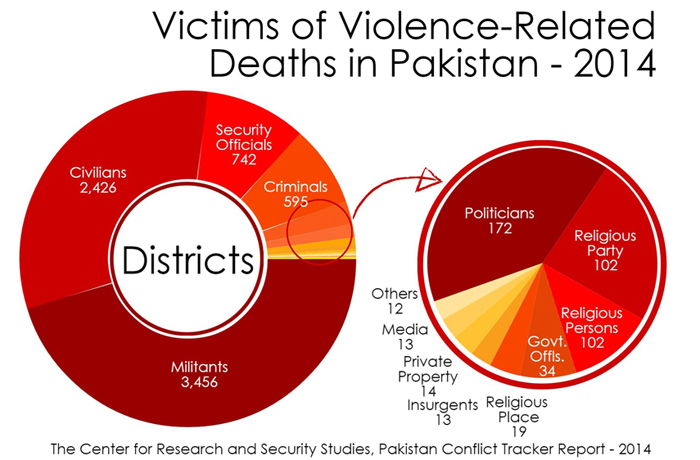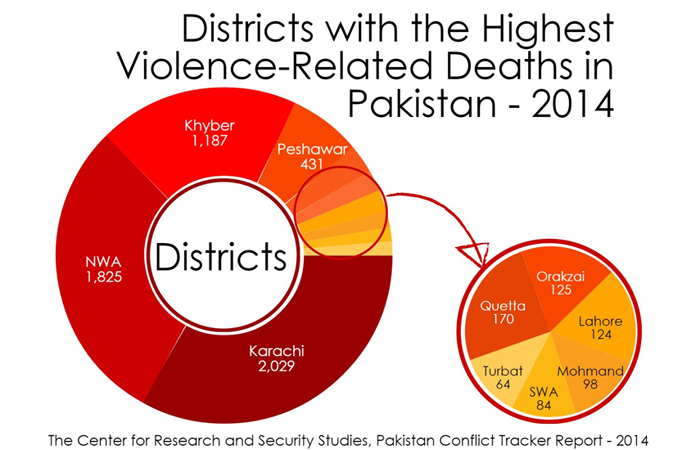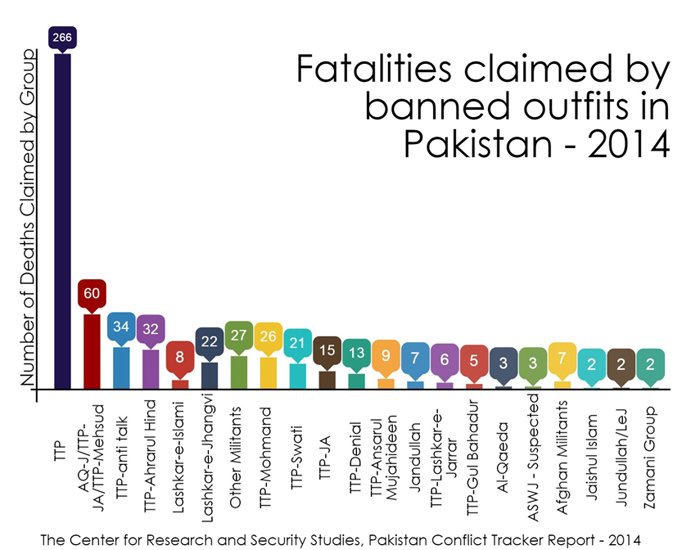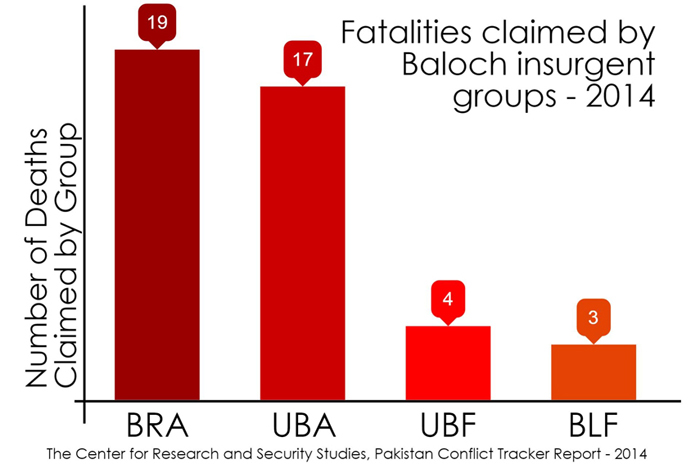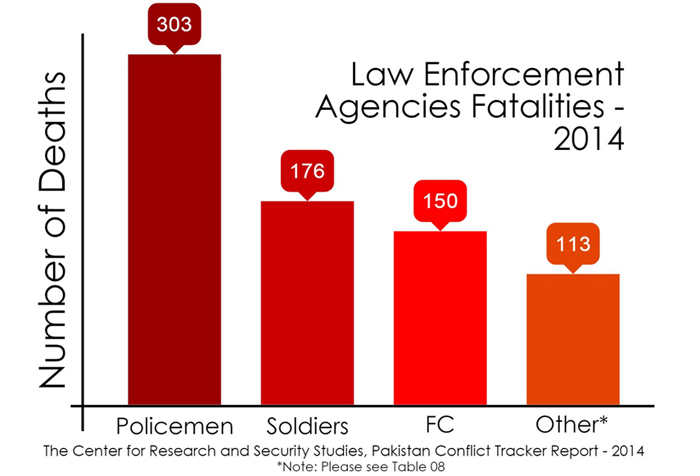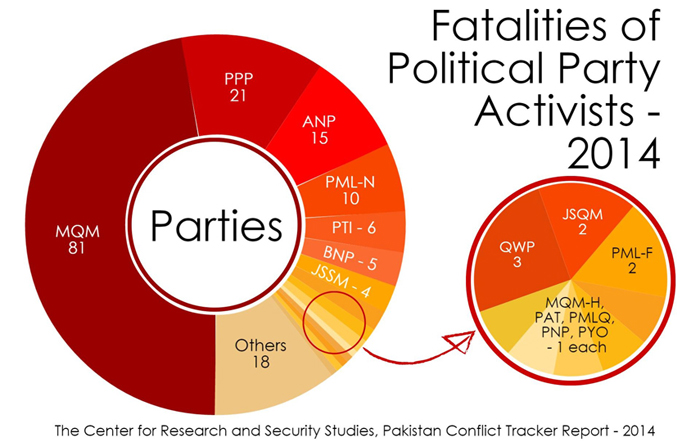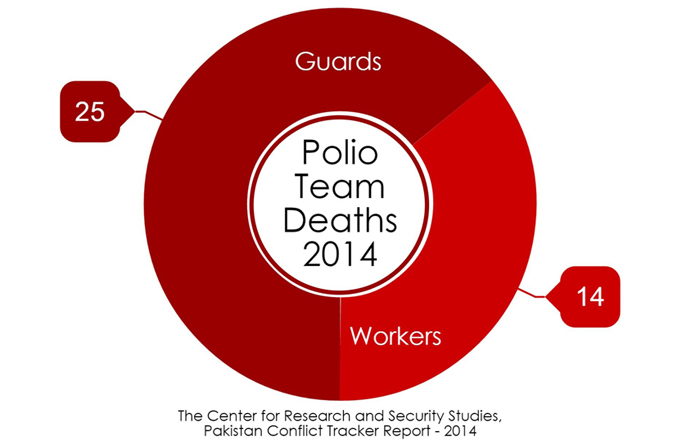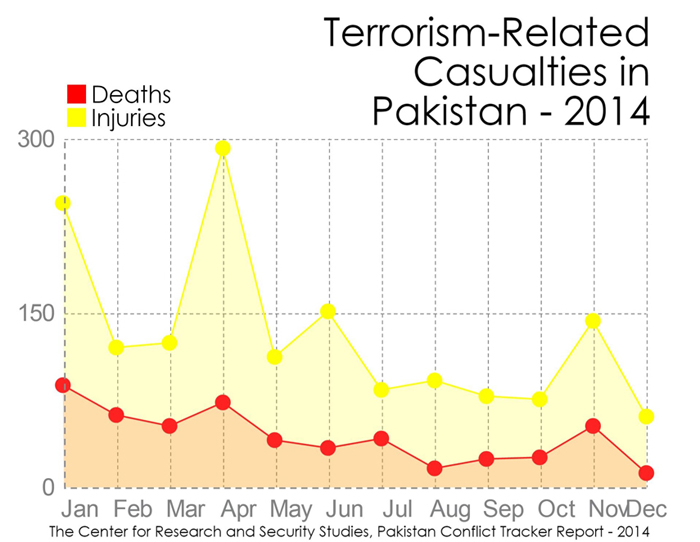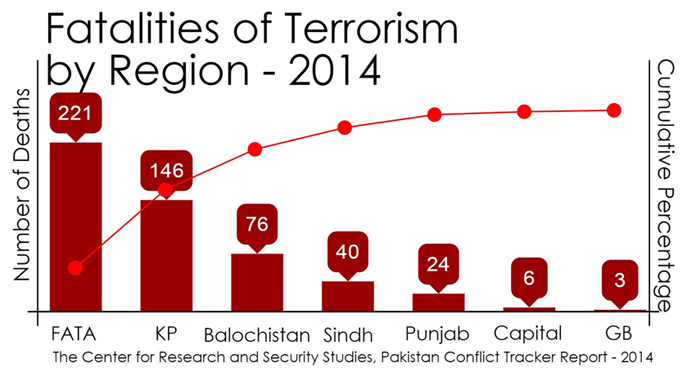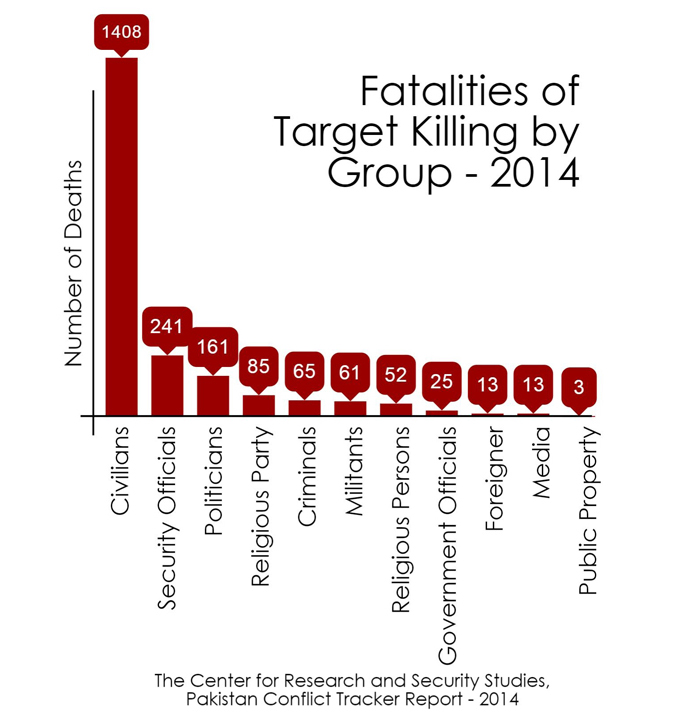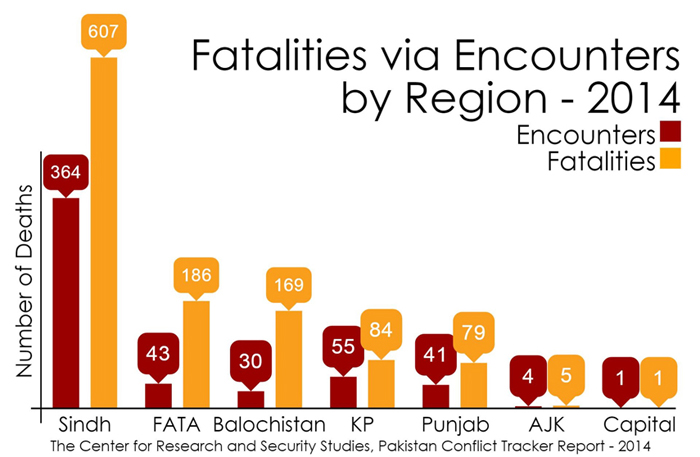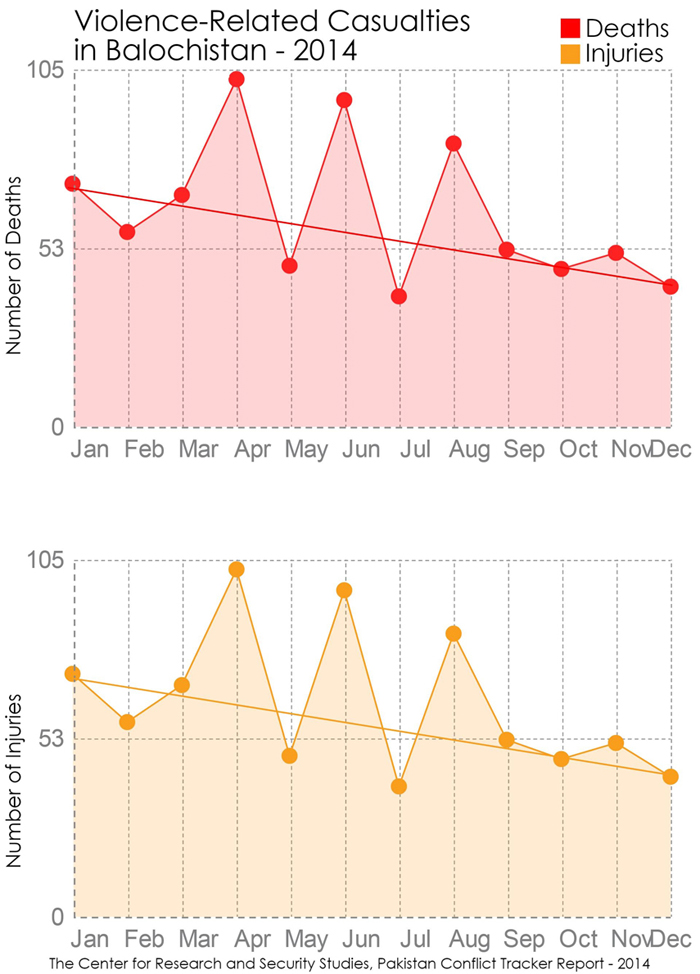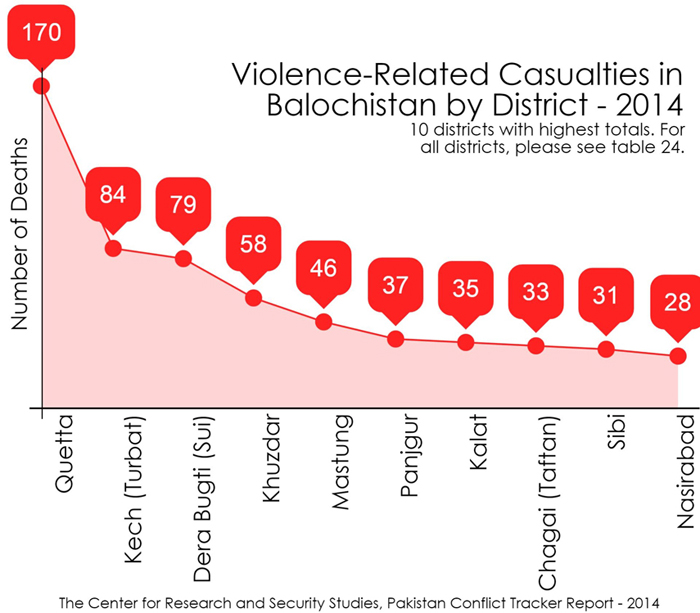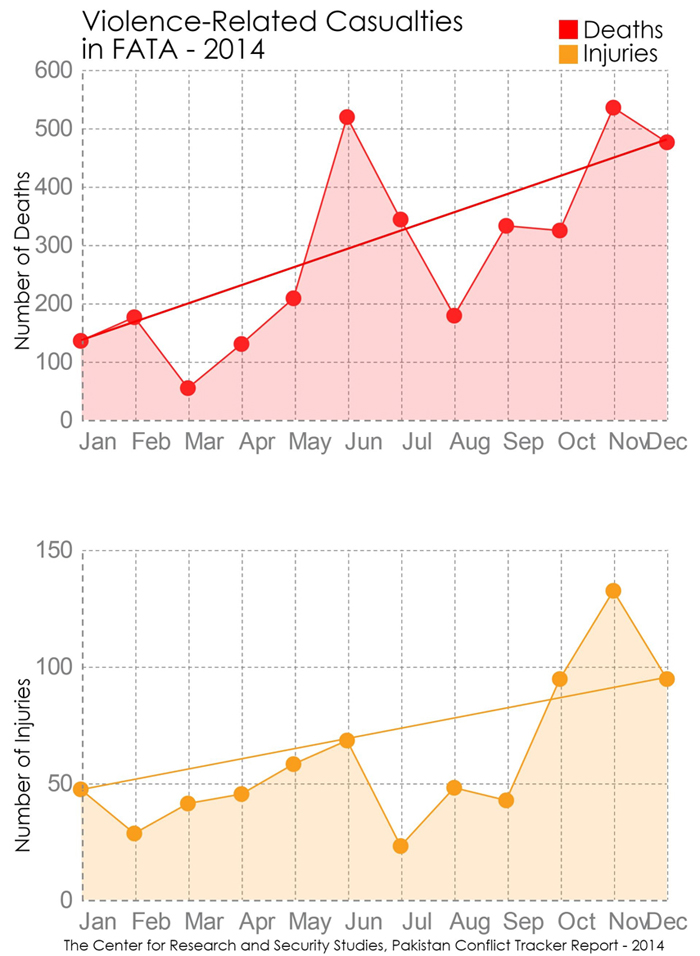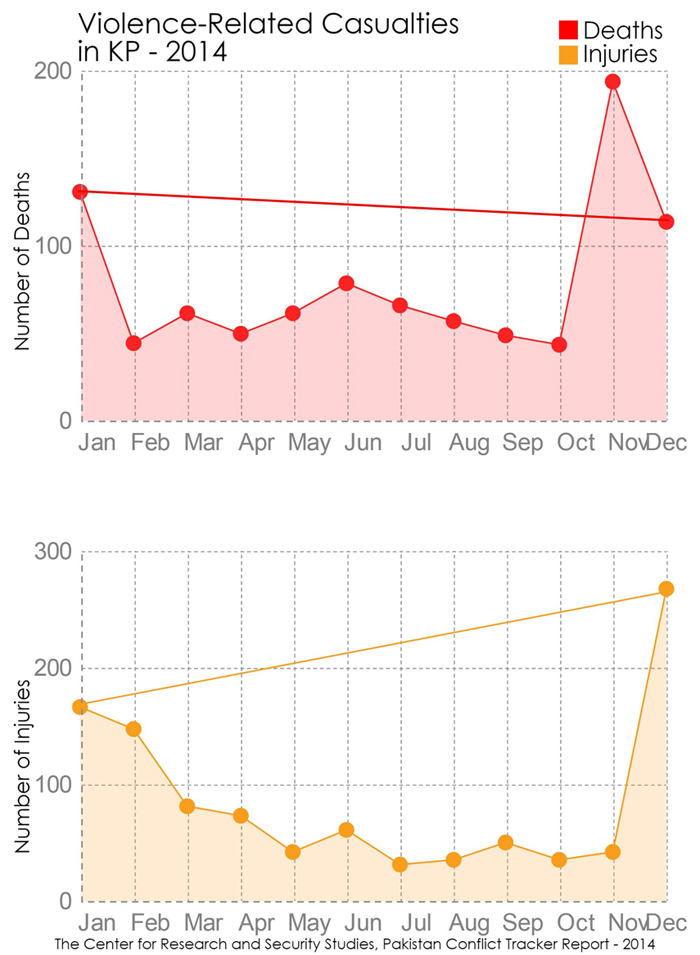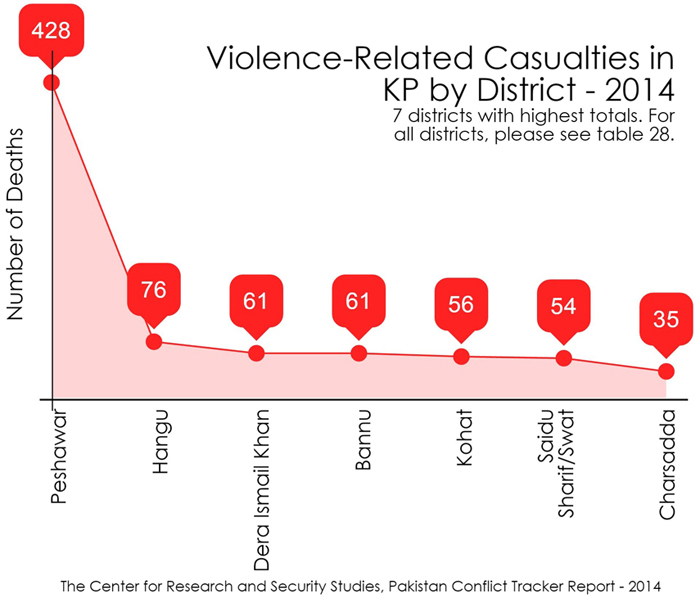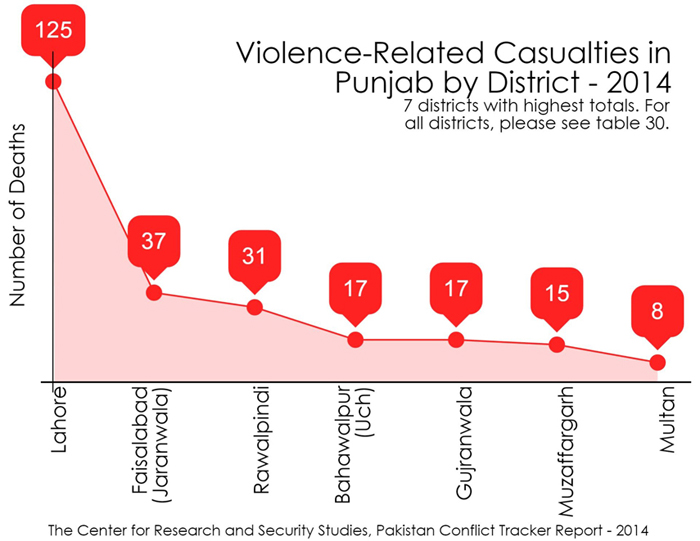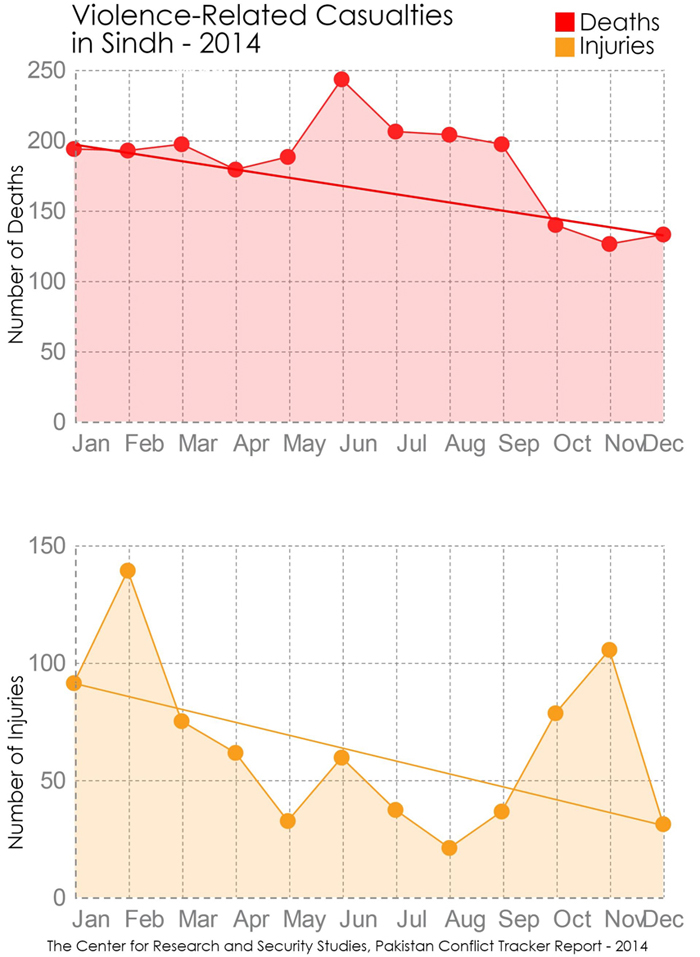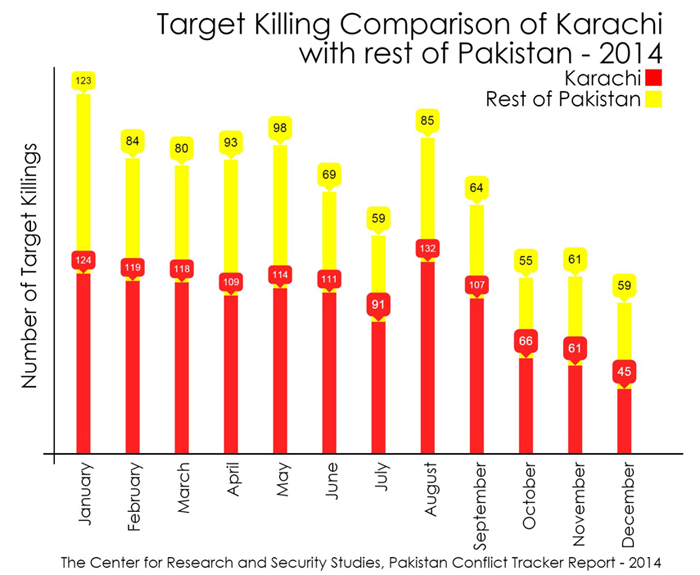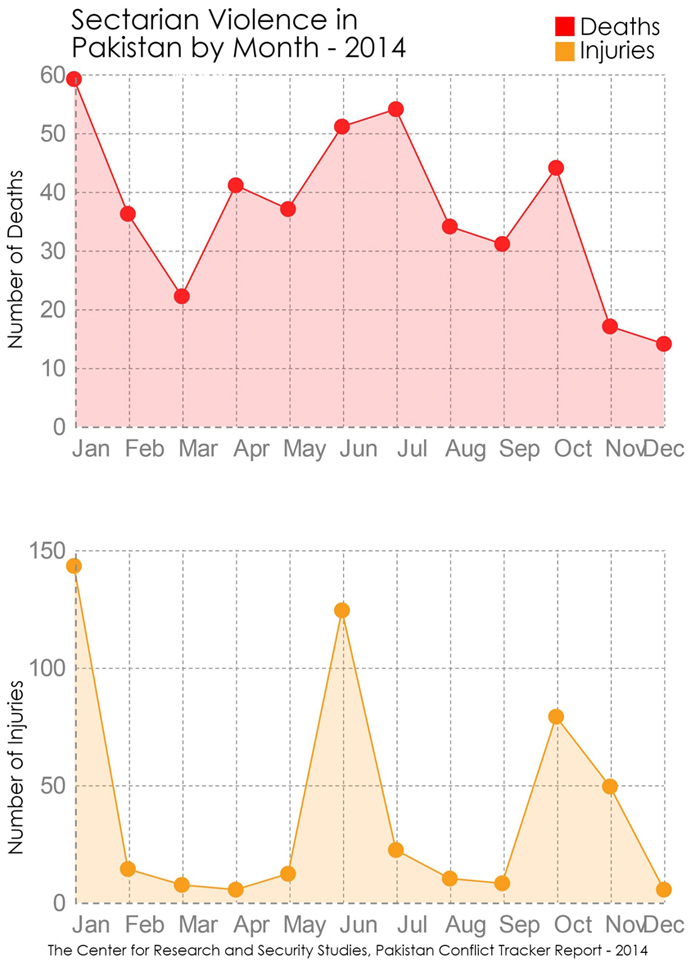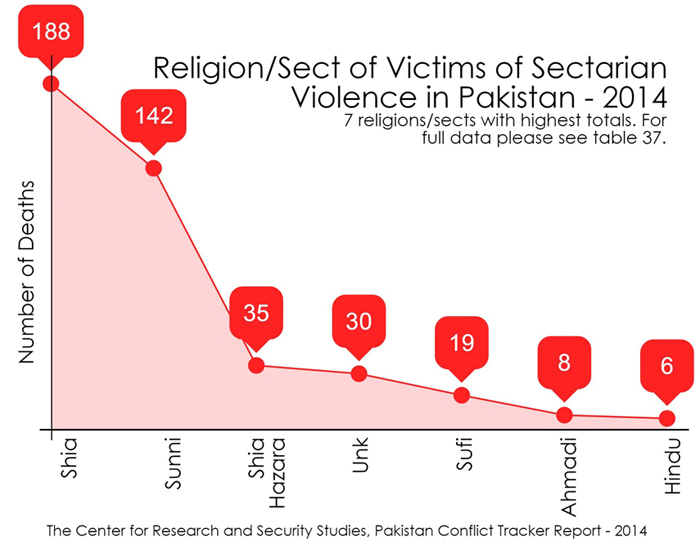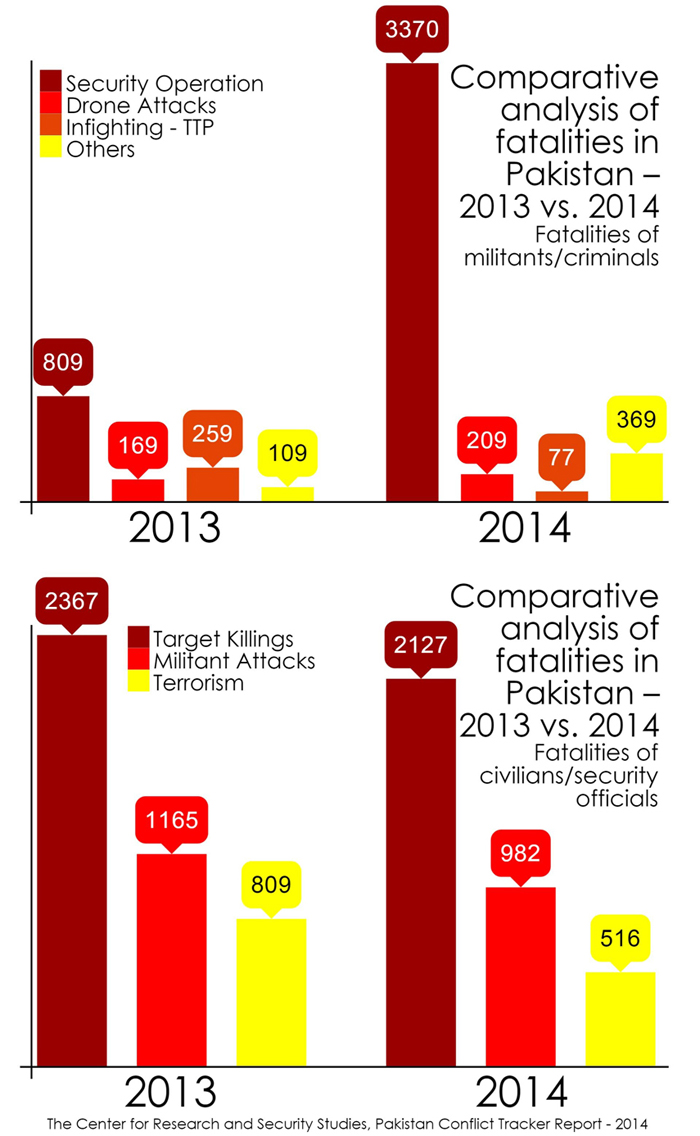The year 2014 began with a resolve of holding negotiations with the militants and it ended with a consensus of eliminating extremism categorically. This was the result of the two horrific game-changing incidents. These were brazen attacks on Karachi Airport and the Army Public School in Peshawar. A decade of fighting against a nameless and faceless monster has finally reached a point where traditional blame gaming, rhetoric, and lack of political will have lost their credence. Pakistan, at least on paper, emerged with an unwavering determination to eliminate this enemy permanently.
Significant difference of opinion still exists as to who is actually pulling the strings behind these elements. For some, it is some kind of conspiracy[1] or the domain of foreign hands[2], whereas for others it is the ideological paradigm of the country that keeps breeding and nurturing this monster.
This annual report analyzes violence in Pakistan empirically, using factual data and the pattern of violence drawn from the incidents of crimes committed in the country. The subjects to be covered in this report are:
All assessments and reviews are based on the data collected from reports appearing in the local press. Efforts are made to maintain the data as accurate as possible within the available resources. Errors and omissions, as always a possibility in all statistical works including this one, are expected. However, such mistakes do not grossly affect the overall outcome of this report.
This report has been prepared by Mohammad Nafees, Senior Research Fellow, CRSS, and edited by Zeeshan Salahuddin, Senior Research Fellow, CRSS.
Readers can approach CRSS for the source of any information included in the report. Please send your request to mail@crss.pk.
Casualties of Violence in the Country – 2014
Pakistan faced a range of internal security issues in 2014, resulting in a wide variety of forms of violence. These include terrorism, militant attacks, sectarian violence, crime, target killings, security operations and drone strikes that left 7,650 persons dead and 3,946 wounded (table 01). A review of the monthly trend of violence reflects that it was on the rise as the year progressed (graph 01).
Table 01: Casualties of Violence in Pakistan – 2014:
| Casualties from Violence in Pakistan | |||
| Month | Killed | Injured | Total Casualties |
| Jan | 544 | 446 | 990 |
| Feb | 570 | 361 | 931 |
| Mar | 387 | 348 | 735 |
| Apr | 507 | 427 | 934 |
| May | 514 | 192 | 706 |
| Jun | 958 | 419 | 1377 |
| Jul | 690 | 175 | 865 |
| Aug | 542 | 201 | 743 |
| Sep | 651 | 210 | 861 |
| Oct | 589 | 295 | 884 |
| Nov | 829 | 421 | 1250 |
| Dec | 869 | 451 | 1320 |
| Total | 7650 | 3946 | 11596 |
Graph 01: Casualties from violence in Pakistan – 2014:
Compared to 5,687 deaths in 2013, a total of 7,650 people died in 2014 as a direct result of violence, which is an average increase of about 35%. The sudden spike from June 2014 onwards is clearly attributable to the start of Operation Zarb-e-Azb. Deaths from violence accelerated towards the end of the year, pulling significantly ahead of the same-month figures from 2013. The last three months in 2014 were especially bloody, with an alarming 258% increase from the same period in 2013.
The most significant increase in violence was observed in the Federally Administered Tribal Areas (FATA), where fatalities more than doubled from 1,457 in 2013 to 3,400 in 2014 (table 02, graph 02). A big reason for this marked increase is the military-led Operation Zarb-e-Azb in the North Waziristan Agency of the FATA region. The second largest increase was in Punjab, where death from violence rose from 120 in 2013 to 307 in 2014, a drastic increase of 156% (table 02, graph 02). This increased figure, in part, may be attributed to the November 2, 2014 bombing of the Wagah border closing ceremony, which left 60 dead. Khyber Pukhtunkhwa (KP) saw a decrease in violence-related deaths, with 941 deaths in 2014, as compared to the 1,031 deaths in 2013 (table 02, graph 02). Gilgit Baltistan (GB) saw the largest percentage decrease in violence-related casualties, at 3 in 2014, from 20 in 2013 (table 02, graph 02).
Table 02: Comparative Regional Analysis of Fatalities in Pakistan – Year 2013 vs. 2014:
| Province | 2013 | 2014 | % Change |
| Sindh | 2086 | 2193 | 5.13 |
| FATA | 1457 | 3400 | 133.36 |
| KP | 1031 | 941 | -8.73 |
| Baluchistan | 950 | 752 | -20.84 |
| Punjab | 120 | 307 | 155.83 |
| Islamabad | 20 | 48 | 140.00 |
| Gilgit Baltistan | 20 | 3 | -85.00 |
| AJK | 3 | 6 | 100.00 |
| Total | 5687 | 7650 | 34.52 |
Graph 02: Comparative Regional Analysis of Fatalities in Pakistan – Year 2013 vs. 2014:
All in all, compared to last year the fatalities from security operations are three times higher, while the fatalities from militant attacks, terrorism and target killings are more than 15% lower this year (table 03, graph 03).
Table 03: Comparative Analysis of Causes of Violence-Related Deaths in Pakistan –2013 vs. 2014:
| Fatalities from violence in Pakistan – 2013-14 | |||
| Nature of Violence | 2013 | 2014 | % change |
| Target Killings | 2367 | 2127 | -10.14 |
| Militant Attacks | 1165 | 982 | -15.71 |
| Security Operation | 809 | 3370 | 316.56 |
| Terrorism | 809 | 516 | -36.22 |
| Infighting – TTP | 259 | 77 | -70.27 |
| Drone Attacks | 169 | 209 | 23.67 |
| Other | 109 | 369 | 238.53 |
| Total | 5687 | 7650 | 34.52 |
Graph 03: Comparative Analysis of Causes of Violence-Related Deaths in Pakistan –2013 vs. 2014:
This year, the combined figure of militant and criminal fatalities was more than 50% of the total fatalities while the total casualties of civilians (dead and wounded) were the highest among all other victims (table 04, graph 04). The other victims of violence belonged to security agencies, political parties, religious parties, religious persons, and media persons (table 04, graph 04).
Table 04: Victims of Violence-Related Deaths in Pakistan – 2014:
| Victims of Violence – 2014 | |||
| Victims of violence | Fatalities | Injuries | Total Casualties |
| Militants | 3456 | 328 | 3784 |
| Civilians | 2426 | 2420 | 4846 |
| Security Officials | 742 | 731 | 1473 |
| Criminals | 595 | 61 | 656 |
| Politicians | 172 | 34 | 206 |
| Religious Party | 102 | 38 | 140 |
| Religious Persons | 52 | 26 | 78 |
| Govt Officials | 34 | 43 | 77 |
| Religious Place | 19 | 129 | 148 |
| Insurgents | 13 | 0 | 13 |
| Private Property | 14 | 68 | 82 |
| Media | 13 | 8 | 21 |
| Others | 12 | 6 | 18 |
| Total | 7650 | 3892 | 11542 |
Graph 04: Victims of Violence-Related Deaths in Pakistan – 2014:
District Level Fatalities:
The highest fatalities were observed in the district of Karachi, at 2,029 (table 05, graph 05). North Waziristan Agency and Khyber Agency in FATA witnessed 1,818 and 1,185 deaths respectively (table 05, graph 05). It is worth mentioning that while Karachi had the highest number of violence-related deaths, that the collective deaths in FATA are significantly greater than those in Karachi. KP’s capital city Peshawar had 431 deaths, while Baluchistan’s capital Quetta saw 170 followed by the Punjab’s capital Lahore with 127 fatalities (table 05, graph 05). Table and graph 05 provide details for other districts below.
Table 05: Violence-Related Deaths – District Breakdown – 2014:
| Fatalities from Violence by District | |
| Districts | 2014 |
| Karachi | 2029 |
| N. Waziristan | 1818 |
| Khyber Agency | 1185 |
| Peshawar | 428 |
| Quetta | 170 |
| Lahore | 124 |
| Orakzai Agency | 125 |
| Mohmand Agency | 98 |
| S. Waziristan | 84 |
| Turbat | 83 |
| Dera Bugti | 79 |
| Hangu | 76 |
| Sukkur | 67 |
| Bajaur | 63 |
| D.I. Khan | 62 |
| Bannu | 61 |
| Khuzdar | 58 |
| Kohat | 54 |
| Swat | 55 |
| Islamabad | 48 |
| Mastung | 46 |
| Kalat | 38 |
| Panjgur | 37 |
| Hyderabad | 37 |
| Faisalabad | 35 |
| Charsadda | 35 |
| Nowshera | 26 |
| Muzaffargarh | 18 |
| Pishin | 18 |
| Others | 593 |
| Total | 7650 |
Graph 05: Violence-Related Deaths – District Breakdown – 2014:
Fatalities Claimed by Banned/Proscribed Militant Organizations:
1,498 of the total fatalities were a direct result of terror attacks, of which militant organizations claimed responsibility for 613 (tables 06 and 07, graph 06 and 07). Thus, 40.9% of all fatalities attributed to terror attacks were claimed by militant groups (tables 06 and 07, graph 06 and 07).
Table 06: Fatalities Claimed by Banned Militant Organizations – 2014:
| Fatalities Claimed by Banned Militant Organizations | |
| Claimants | 2014 |
| TTP | 266 |
| AQ-J/TTP-JA/TTP-Mehsud | 60 |
| TTP-anti talk (suspected) | 34 |
| TTP-Ahrarul Hind | 32 |
| Lashkar-e-Islami | 8 |
| Lashkar-e-Jhangvi (LeJ) | 22 |
| Other Militants | 27 |
| TTP-Mohmand Agency | 26 |
| TTP-Swati | 21 |
| TTP-JA | 15 |
| TTP-Denial | 13 |
| TTP-Ansarul Mujahideen | 9 |
| Jandullah | 7 |
| TTP-Lashkar-e-Jarrar | 6 |
| TTP-Gul Bahadur | 5 |
| Al-Qaeda | 3 |
| ASWJ – Suspected | 3 |
| Afghan Militants | 7 |
| Jaishul Islam | 2 |
| Jundullah/LeJ | 2 |
| Zamani Group | 2 |
| Total | 570 |
Graph 06: Fatalities Claimed by Banned Militant Organizations – 2014:
Table 07: Fatalities Claimed by Baloch Insurgent Groups – 2014:
| Baloch Insurgent Groups | |
| Claimants | 2014 |
| BRA (Baloch Republican Army) | 19 |
| UBA (United Baloch Army) | 17 |
| UBF (United Baloch Front) | 4 |
| BLF (Baloch Liberation Front) | 3 |
| Total | 43 |
| Grand Total | 613 |
Graph 07: Fatalities Claimed by Baloch Insurgent Groups – 2014:
Victims of violence in Pakistan – 2014:
No segment of society was safe from the violence in 2014. Security personnel, political party activists, religious party activists, religious persons, health and educational professionals, and many others were all affected. Table 08, 09, 10, 11 and 12, as well as graph 08, 10 and 12 below reflect the number of victims belonging to different segments of the society that lost their lives during 2014:
Table 08: Fatalities of Law-Enforcement Agencies (LEAs) – 2014:
| Fatalities of LEAs | |
| Security Agencies | Fatality |
| Policemen | 303 |
| Soldiers | 176 |
| FC personnel | 150 |
| Levies | 35 |
| Khassadar | 28 |
| Rangers | 21 |
| ASF Guards | 12 |
| Baloch Constabulary | 6 |
| Elite Force – Police | 3 |
| Police volunteer | 2 |
| Pak Navy | 2 |
| Police Informer | 1 |
| Sensitive agency | 1 |
| ISI | 1 |
| PAF | 1 |
| Total | 742 |
Graph 08: Fatalities of Law-Enforcement Agencies (LEAs) – 2014:
Table 09: Fatalities of Religious Party Activists –2014:
| Fatalities of Religious Party Activists | |
| Name of Party | Fatality |
| Ahle-e-Sunnat Wal Jamat (ASWJ) | 56 |
| Sunni Tehreek (ST) | 11 |
| Jamat-e-Islami (JI) | 9 |
| Jamiat-e-Ulema-e-Islam (Fazlur Rehman) JUI-F | 9 |
| Majlis-e-Wahdat-ul-Muslimeen (MWM) | 7 |
| Jamiat-e-Ulema-e-Islam (Samiul Haq) JUI-S | 3 |
| Tableeghi Jamaat | 2 |
| Tehreek-e-Nifaz-e-Jafaria (TNFJ) | 2 |
| Imamia Student Organisation (ISO) | 4 |
| Jamiat-e-Ulema-e-Islam (JUI) | 1 |
| Religious Group | 1 |
| Religious Party | 1 |
| Sipah-e-Sahaba | 1 |
| Total | 107 |
Table 10: Fatalities of Political Party activists – 2014:
| Fatalities of Political Party Activists | |
| Party | Fatality |
| Muttahida Qaumi Movement (MQM) | 81 |
| Pakistan People’s Party (PPP) | 21 |
| Awami National Party (ANP) | 15 |
| Pakistan Muslim League – Nawaz (PMLN) | 10 |
| Pakistan Tehrik-e-Insaaf (PTI) | 6 |
| Balochistan National Party (BNP) | 5 |
| Jeay Sindh Muttahida Mahaz (JSMM) | 4 |
| Qaumi Watan Party (QWP) | 3 |
| Jeay Sindh Quomi Mahaz (JSQM) | 2 |
| Pakistan Muslim League – Functional (PMLF) | 2 |
| Muttahida Qaumi Movement – Haqiqi (MQM-H) | 1 |
| Pakistan Awami Tehrik (PAT) | 1 |
| Pakistan Muslim League – Quaid (PMLQ) | 1 |
| Pakistan National Party (PNP) | 1 |
| People’s Youth Organization (PYO) | 1 |
| Others | 18 |
| Total | 172 |
Graph 10: Fatalities of Political Party activists – 2014:
Table 11: Fatalities of Religious Persons – 2014:
| Fatalities of religious persons | |
| Identity | Fatality |
| Pesh Imam | 10 |
| Shrine caretaker | 8 |
| Worshippers (Zikri) | 6 |
| Others | 6 |
| Maulana | 4 |
| Madressa Teacher | 3 |
| Religious scholar, shia zakir, sufi | 3 |
| Aalim | 2 |
| Pesh Imam/Moazzan | 2 |
| Qari | 2 |
| Afghan Aalim | 1 |
| Khateeb | 1 |
| Madressa Head | 1 |
| Mufti | 1 |
| Total | 50 |
The list of victims of violence doesn’t end here. The menace of terrorism has gobbled up even those innocent people who provide health support, education, and information to the people of this country. The table 11 below gives a snap shot of all these victims:
Table 12: Identity of Victims of Violence – 2014:
| Identity of Victims of Violence – Year 2014 | Fatality |
| Polio Campaign Victims | |
| Polio Guard | 25 |
| Polio Worker | 14 |
| Total | 39 |
| Education, Health, Judiciary, and Media Victims | |
| Students/Teachers/Instructors | 146 |
| Professors/Principals | 26 |
| Doctors | 22 |
| Lawyers | 12 |
| Judges | 2 |
| Journalists | 13 |
| Total | 217 |
Graph 12: Polio Campaign Victims – 2014:
Nature and Method of Violence:
Militant attacks[3], terrorism[4], and target killings[5] are the three very common forms of violence that are used by the different extremist, sectarian, and lawless outfits in pursuit of their criminal objectives. The majority of the cases included in this report are related to these three crimes. Another major cause of fatalities in the country are the ongoing security operations. Over 90% of total fatalities from violence fall into these four categories and a brief review of them will explain some of the root causes.
Militants’ attacks:
As many as 93 armed attacks were recorded during last year that left 306 people dead in the country. These attacks were reported from all over the country and served as one of the main reasons for the initiation of military operations in the North Waziristan and Khyber. The first deadly attack took place in Islamabad on March 4, 2014, when militants wielding hand grenades and guns stormed a district court and resorted to indiscriminate firing that left 11 dead and 30 wounded. A splinter group of the Tehreek-e-Taliban (TTP) identifying itself as Ahrar-ul-Hind claimed the responsibility for the attack. The group had recently parted ways with the TTP over holding peace talks with the government.
The spokesman of the group claimed that the court was targeted as the prevailing system in the country was un-Islamic which included the courts and its administration. He added that their struggle would continue until Shariah law was implemented in Pakistan. The TTP denied any involvement with this group and condemned this attack[6]. Other militant attacks began in FATA and Baluchistan. Well-armed militants from across the border in Afghanistan started attacking military posts in Pakistan as well. Some of these incidents are detailed below:
- May 25, five paramilitary Frontier Corps soldiers were wounded in an attack on a checkpost.[7]
- May 31, at least 14 militants were killed when Pakistani border guards had repelled a cross-border attack on a military post. In a statement, the Foreign Office had put the number of attackers at over 200.[8]
- 5 June, Militants storm checkposts in Bajaur from Afghanistan.[9]
Amid these cross-border attacks another blow to the country’s security was the brash attack on Muhammad Ali Jinnah Airport in Karachi that left 39 dead (including the 12 attackers). It was the proverbial straw that broke the camel’s back. A week after this attack, on June 15, 2014, Pakistan Army began Operation Zarb-e-Azb in North Waziristan, FATA. The major militant attacks after June 15, 2015 were as follows:
- July 7, GWADAR: A group of men attacked a Levies check post in Gwargo area of Panjgur district in Baluchistan and captured weapons and wireless equipment.[10]
- July 12, PESHAWAR: Militants attacked a security checkpost along the Pakistan-Afghanistan border in Bajaur tribal agency in FATA, killing three personnel including a captain. Militants from across the border in Kunar province of Afghanistan attacked the security check-post in Mohmand area.[11]
- August 16, QUETTA: At least 12 militants, wearing suicide vests and armed with rocket-propelled grenades (RPGs) and automatic weapons were killed in an eleven-hour gun battle near Khalid Aviation airbase and Samungli airbase in Quetta. TTP spokesperson Azam Tariq said on Friday that the attack was in retaliation for Operation Zarb-e-Azb in North Waziristan Agency.[12]
- August 23, ISLAMABAD: A paramilitary soldier was killed in an exchange of firepower with militants who entered the Pakistani territory from Afghanistan on Friday, the military said. “About 70-80 terrorists intruded from (the) Afghanistan side into the Pakistani territory,” the military said in a statement.[13]
- September 9, KARACHI: Pakistan Navy on Monday said it had thwarted a terror attack on the Navy Dockyard here Saturday night, following Defence Day celebrations. At least two terrorists were killed and four others were captured during a 6-hour long firefight with the intruders.[14]
- September 17, SWABI: Police repulsed a midnight attack on a police post at Swabi-Buner boundary area, an official said on Tuesday. “About 15 militants attacked the Darran police post from the two different directions at mid-night.”[15]
- September 17, MIRANSHAH: Twenty militants and four personnel of the Tochi Scouts Wing of the paramilitary Frontier Corps (FC) were killed and another sustained injuries when Afghanistan-based militants attacked the Dandi Kach checkpost in Spinwam Tehsil in North Waziristan Agency on Tuesday, tribal sources said. Sources said that some 700 Afghanistan-based militants stormed the Dandi Kach checkpost near the Afghan border at around 6:20am and killed four soldiers manning the picket.[16]
- November 9, BARA: Seventeen militants were killed in a clash after a group of militants stormed a checkpost of the security forces in the Spin Qabar area in Bara tehsil of Khyber Agency, official sources said on Saturday. The sources said at least 60 militants stormed the security forces’ checkpost in Spin Qabar early in the day.[17]
- November 11, PESHAWAR: Militants mounted an attack on the check post located in Shirindara area, however, were effectively repelled. “More than 50 militants attacked the check post. Two soldiers embraced martyrdom while 15 terrorists were killed in an exchange of fire,” a senior security official told AFP.[18]
- December 16, PESHAWAR: Terrorists attacked the Army Public School in Peshawar, leaving 141, including 132 children, dead. Principal, teachers and army instructors also martyred, 250 hurt. TTP, al-Qaeda Taliban claim responsibility for attack. Seven terrorists wearing FC uniforms entered school from the back.[19]
- December 22, WANA: Twenty-five terrorists were killed and three soldiers sustained injuries in a clash in the South Waziristan Agency on Sunday, official sources said. The sources said about 200 militants, equipped with light and heavy weapons, in the small hours of Sunday attacked the Baghzai check post manned by the Pakistan Army 30-Baloch Regiment in the Shawal area.[20]
- December 28, HANGU: The military claims to have killed at least 16 militants in a ground operation in the Orakzai tribal region.
Besides these armed attacks, there were 30 suicide attacks that killed 196 people and wounded 504 in the country. The highest number of fatalities from suicide attacks were recorded in the Punjab (81) followed by KP (41), Baluchistan (32), Sindh (17), FATA (13) and Islamabad (11). Among victims the highest number of fatalities belonged to civilians (142) and the next highest victims were security and government officials (45). Out of 142 fatalities of civilians, 29 belonged to the Shia community and 7 belonged to the Sunni community. The highest number of civilians at a single bombing was 60: the unfortunate attendees of the flag hoisting ceremony at the Wagah border. Nearly 90% of suicide attacks were claimed to have been carried out by different militant organizations.
Table 13: Fatalities in Suicide Attacks Claimed by Banned Militant Organizations – 2014:
| Claimants of Suicide Attacks – 2014 | Fatalities |
| AQ-J/TTP-JA/TTP-Mehsud | 60 |
| TTP | 42 |
| LeJ | 22 |
| TTP-Ahrarul Hind | 22 |
| TTP-Swati | 9 |
| Lashkar-e-Islami (LI) | 4 |
| Ansarul Mujahideen | 4 |
| Jundullah | 4 |
| Total | 167 |
These were not the only methods that the militants used to carry out their operations. They resorted to hurling of hand grenades, mortar fires, and rocket fires. The number of such attacks and the resultant fatalities are below.
Table 14: Other Forms of Terror Attacks and Fatalities Caused – 2014:
| Other Forms of Terror Attacks | ||
| Type of Attack | Number of Attacks | Fatalities |
| Hand grenade | 91 | 55 |
| Mortars | 80 | 48 |
| Rockets | 74 | 44 |
| Indiscriminate firing | 46 | 305 |
Over 2,000 people were killed and/or wounded as a result of explosions of bombs, IEDs, landmines, and toy bombs in the country. More than 60% of these casualties were recorded during the first half the year (January – June), i.e., before the launch of military operation.
Table 15: Casualties of Terrorism – 2014:
| Terrorism Casualties | Dead | Injured |
| January | 87 | 244 |
| February | 61 | 120 |
| March | 52 | 124 |
| April | 73 | 291 |
| May | 40 | 112 |
| June | 33 | 151 |
| July | 42 | 83 |
| August | 16 | 92 |
| September | 24 | 78 |
| October | 25 | 75 |
| November | 52 | 143 |
| December | 11 | 60 |
| Total | 516 | 1573 |
Graph 15: Casualties of Terrorism – 2014:
The number of these explosions and their resultant fatalities are listed below. It is also worth mentioning that 87 bombs were also defused in 2014, which undoubtedly prevented significant loss to life and property.
Table 16: Fatalities from Different Types of Explosions – 2014:
| Fatalities from Different Types of Explosions | ||
| Type of Explosion | Number of Attacks | Fatalities |
| Bomb explosions | 419 | 299 |
| IED explosions | 98 | 125 |
| Landmines | 33 | 28 |
| Toy bombs | 7 | 5 |
No region of the country was safe from these incidents of terrorism, while FATA was the most affected. Over 90% of the victims of this violence were civilians or security officials. Nearly a third of these explosions were claimed to have been carried out by the TTP and its different splinter groups, as well as some insurgent outfits in Baluchistan.
Table 17: Fatalities of Terrorism by Region – 2014:
| Fatalities of Terrorism by Region – 2014 | |
| Location | Fatalities |
| FATA | 221 |
| KP | 146 |
| Baluchistan | 76 |
| Sindh | 40 |
| Capital | 24 |
| Punjab | 6 |
| GB | 3 |
| Total | 516 |
Graph 17: Fatalities of Terrorism by Region – 2014
Target Killings:
Dead = 2,127
Injured= 345
Target killing was the cause of second highest number of fatalities in the country and the two methods, gunning down and dumping dead bodies after kidnapping, were commonly used to carry out this crime. As many as 1,557 people were gunned down in the country while 530 dead bodies were found from all over the country. The majority of dead bodies were found in Sindh (270) followed by Baluchistan (96), FATA (80), KP (67), Punjab (16), and Islamabad (1). No one ever claimed responsibility for target killing incidents though the victims of this violence belonged to all segments of the society (table 18, graph 18). The actual causes and motivation of this violence vary from political rivalry to sectarian hatred and other criminal objectives.
Table 18: Fatalities of Target Killings by Group – 2014:
| Fatalities of Target Killings by Group – 2014 | |
| Location | Fatalities |
| Civilians | 1408 |
| Security Officials | 241 |
| Politicians | 161 |
| Religious Party | 85 |
| Criminals | 65 |
| Militants | 61 |
| Religious Persons | 52 |
| Government Officials | 25 |
| Foreigner | 13 |
| Media | 13 |
| Public Property | 3 |
| Total | 2127 |
Graph 18: Fatalities of Target Killings by Group – 2014:
Security Operation:
This year, fatalities from security operations went up three times compared to last year, largely because of the Operation Zarb-e-Azb that was launched on June 15, 2014 and the ongoing Rangers’ operation in Karachi since September 2013. All in all 3,370 people were killed in these operations and the highest fatalities were reported from FATA (2,351) followed by Sindh (609), Baluchistan (216), KP (108), AJK (5) and Islamabad (1). Air raids and encounters with the outlaws were the two main causes of fatalities that are attributed to counter violence security operations in the country. As many as one hundred (100) reports of air raids appeared in the press that left 1,936 persons dead, whereas and 1,131 alleged outlaws were killed as a result of 538 encounters. These air raids were carried out primary in FATA (96), with 5 additional air raids in Punjab (1), Baluchistan (1) and KP combined (3) (table 19).
The nature of air raids in FATA and other settled areas in KP, Baluchistan, and Punjab are different. In FATA, security forces used jet fighters and gunship helicopters to target the militants’ hideouts in the mountainous regions while in other parts of the country the ground forces were provided aerial coverage by the security forces helicopters.
Table 19: Fatalities via Air Raids – 2014:
| Fatalities via Air Raids – 2014 | ||
| Province | No. of Air Raids | Fatalities |
| Punjab | 1[21] | 0 |
| Baluchistan | 1[22] | 10 |
| KP | 3 [23][24][25] | 12 |
| FATA | 96 | 1914 |
| Total | 101 | 1936 |
Table 20: Fatalities via Encounters by Region – 2014:
| Fatalities via Encounters – 2014 | ||
| Province | No. of Encounters | Fatalities |
| Sindh | 364 | 607 |
| FATA | 43 | 186 |
| Baluchistan | 30 | 169 |
| KP | 55 | 84 |
| Punjab | 41 | 79 |
| AJK | 4 | 5 |
| Islamabad | 1 | 1 |
| Total | 538 | 1131 |
Graph 20: Fatalities via Encounters by Region – 2014:
Militant Commanders – Killed or Captured
Several commanders of different militant organizations like TTP, Al-Qaeda, Hanafi Group, TTP-Swati, and many others were killed or captured in 2014. The following list contains names of these commanders and the locations where they are killed or arrested:
Table 21: Militant commanders killed or arrested – 2014:
| Date | Source | City | Affiliation | Name of Victims |
| Jan-14 | The News | N.Waziristan | TTP | Adnan Rashid, TTP commander |
| Feb-14 | Dawn | N.Waziristan | n/a | Shafiq, Taliban commander + 3 guards |
| Feb-14 | Dawn | Swat | n/a | Commander Umarzada alias Dildar |
| Feb-14 | The News | Islamabad | Changaari Group | Daud Khan, Mardan + Ali Hassan Alias Lehsan |
| Mar-14 | The News | Hangu | Hanafi Group | Mufti Hamid |
| Mar-14 | The News | N.Waziristan | TTP | Aalim Deen Mehsud, TTP commander |
| Apr-14 | The News | N.Waziristan | TTP-Sajna group | Nek Badshah + Nizam, TTP-Sajna commanders |
| Apr-14 | The News | Peshawar | TTP | Jangraiz,TTP commander and four others |
| May-14 | Tribune | S.Waziristan | TTP | Irfan Mehsud, son of Azam Tariq Mehsud |
| May-14 | The News | Peshawar | n/a | Ikram, commander |
| Jun-14 | The News | N.Waziristan | TTP | Ashiqullah Mehsud, TTP commander, suicide bombing expert |
| Jun-14 | The News | Karachi | TTP – Maulvi Khalid group | Zohaib alias Salman |
| Jun-14 | The News | Karachi | TTP – Swat | Jamshaid Ali, worked for Swat TTP commander |
| Jun-14 | The News | N.Waziristan | TTP | Omar, commander |
| Jul-14 | The News | D.I. Khan | n/a | Adnan Rashid |
| Jul-14 | The News | Orakzai | n/a | Amir Salam, commander |
| Aug-14 | The News | Khyber | LI | Wakeel Afridi, LI commander + 4 guards |
| Aug-14 | Tribune | Peshawar | n/a | TTP commander |
| Aug-14 | The News | Khyber | LI | Jan Afridi alias Khybaray, LI commander, Khyber Agency |
| Aug-14 | The News | D.I. Khan | TTP | Walid Akbar |
| Sep-14 | The News | Khyber | n/a | Siddique + Parrak, commanders |
| Sep-14 | Tribune | D.I. Khan | TTP | Salim Shah Je, TTP commander |
| Sep-14 | Tribune | N.Waziristan | TTP | Gul Hasan Afghani, commander |
| Sep-14 | The News | Karachi | TTP – Bhalu group | Mehfoozullah, alias Bhalu Bhai Basikhel |
| Sep-14 | The News | Swat | TTP | Commander captured |
| Oct-14 | The News | Bannu | n/a | Commander + militants arrested |
| Oct-14 | The News | Lakki Marwat | TTP | Commander + militants arrested |
| Oct-14 | The News | Khyber | LI | Israfeel, son of Mangal Bagh + Hanif Khan, commander |
| Nov-14 | The News | Karachi | TTP – Baldia Town | Ameer Abdullah |
| Nov-14 | The News | Karachi | TTP | Qari Abdur Rehman |
| Nov-14 | Tribune | Khyber | TTP | Wajid Abu Bakr, TTP commander, Kuki Khel |
| Dec-14 | The News | S.Waziristan | Al-Qaeda | Adnan el Shukrijumah, in charge of al-Qaeda’s global operations |
| Dec-14 | Tribune | N.Waziristan | Al-Qaeda | Umar al Farooq, Al Qaeda Commander |
| Dec-14 | Tribune | Karachi | Al-Qaeda | Qari Shahid Usman, Al Qaeda Ameer, Karachi |
| Dec-14 | Dawn | Quetta | TTP | TTP commander killed in Ziarat district |
| Dec-14 | The News | Karachi | TTP | Abid Mehsud alias Muchar, TTP chief, Kati Pahari and Manghopir |
| Dec-14 | Dawn | Peshawar | TTP | Mustafa, TTP, Darra Adamkhel Taliban |
| Dec-14 | Dawn | Peshawar | APS Facilitators | Mannan, commander |
| Dec-14 | The News | Khyber | TTP | Tahir, commander, arrested |
| Dec-14 | The News | Bannu | Hayat `Commander’ Group | Dilfaraz alias Taroray, commander |
Sabotage of Infrastructure
Besides the loss of human life, there was significant damage to government and private properties from the sabotage activities carried out by militants and other criminals. A brief summary of sabotage activities is below.
Table 22: Sabotaged Property and Infrastructure – 2014:
| Sabotaged Infrastructure | |
| Houses / guest houses | 128 |
| Vehicles | 153 |
| Airplane | 1 |
| Airport | 2 |
| Schools | 42 |
| College | 3 |
| University | 1 |
| Hospitals | 5 |
| Health units | 2 |
| Factories | 2 |
| Industrial units | 1 |
| Medicine companies | 2 |
| Sugar mills | 1 |
| Frontier Corps’ Arms Depot | 1 |
| Bridges | 5 |
| Cellphone towers | 2 |
| Security check posts | 11 |
| Construction sites | 4 |
| NATO containers | 9 |
| Electric pylons | 11 |
| High power transmission lines | 4 |
| Gas Pipelines | 41 |
| Railway tracks | 18 |
| Shops | 40 |
It is worth noting that not all sabotage activities were successful. The Karachi Airport attack is recognized as a successful counter-terrorism operation, as the militants were not able to cause nearly as much damage to life and property as they had hoped. The cost of damage to infrastructure remains a mystery, though it is safe to assume to be in the range of billions of rupees. The Economic Survey of Pakistan 2013-14 revealed that in the thirteen years of this conflict, losses due to terror attacks amounted to $102.51 billion, which is roughly equivalent to Rs. 8264.4 billion.
Casualties of Violence in Baluchistan
The total loss of human lives in Baluchistan was 752 people, with another 840 wounded. This is a reduction of 20% in the number of fatalities when compared with last year’s 950 violence-related deaths.
Table 23: Casualties from Violence in Baluchistan – 2014:
| Casualties from Violence in Baluchistan | ||
| Month | Dead | Injured |
| January | 71 | 88 |
| February | 57 | 37 |
| March | 68 | 103 |
| April | 102 | 104 |
| May | 47 | 44 |
| June | 96 | 39 |
| July | 38 | 67 |
| August | 83 | 86 |
| September | 52 | 69 |
| October | 46 | 89 |
| November | 51 | 58 |
| December | 41 | 56 |
| Total | 752 | 840 |
Graph 23: Casualties from Violence in Baluchistan – 2014:
Out of 32 districts of Baluchistan 17 had fatalities of ten or more during 2014. Among all districts, the district of Quetta suffered the highest loss of human life. The other highly affected districts of the province were Kech, Dera Bugti, Khuzdar, Mastung, Panjgur, Kalat, Chaghai and Sibi.
Table 24: Fatalities from Violence in Baluchistan by District – 2014:
| Fatalities from Violence in Baluchistan by District – 2014 | |
| Districts | Fatalities |
| Quetta | 170 |
| Kech (Turbat) | 84 |
| Dera Bugti (Sui) | 79 |
| Khuzdar | 58 |
| Mastung | 46 |
| Panjgur | 37 |
| Kalat | 35 |
| Chagai (Taftan) | 33 |
| Sibi | 31 |
| Nasirabad (Dera Murad Jamali) | 28 |
| Awaran | 20 |
| Kachi (Bolan) | 20 |
| Washuk | 19 |
| Pishin | 18 |
| Barkhan | 15 |
| Killa Abdullah | 10 |
| Lasbela | 10 |
| Jafarabad | 8 |
| Jhal Magsi | 7 |
| Loralai | 7 |
| Nushki | 6 |
| Gwadar | 3 |
| Zhob | 3 |
| Ziarat | 3 |
| Killa Saifullah | 2 |
| Harnai | 0 |
| Kharan | 0 |
| Kohlu | 0 |
| Lehri | 0 |
| Musakhel | 0 |
| Sherani | 0 |
| Sohbatpur | 0 |
| Total | 752 |
Graph 24: Fatalities from Violence in Baluchistan by District – 2014:
Casualties of Violence in FATA
FATA suffered the highest number of casualties this year (3,400 dead and 720 wounded) because of the military operation that was launched on June 15, 2014. However, the growing trend of fatalities is recognizable from April 2014, onward (table 25, graph 25).
Table 25: Casualties from Violence in FATA – 2014:
| Fatalities from Violence in FATA | ||
| Month | Dead | Injured |
| January | 135 | 47 |
| February | 175 | 28 |
| March | 54 | 41 |
| April | 130 | 45 |
| May | 207 | 58 |
| June | 517 | 68 |
| July | 343 | 23 |
| August | 176 | 48 |
| September | 331 | 42 |
| October | 322 | 94 |
| November | 535 | 132 |
| December | 475 | 94 |
| Total | 3400 | 720 |
Graph 25: Casualties from Violence in FATA – 2014:
The conflict between armed forces and militants existed well before the full-fledged operation.
- On February 14, 2014, a powerful bomb blast killed 13 young police commandos and injured 58 others in Karachi and the TTP took the responsibility of this attack, claiming it was revenge for the ongoing conflict with the security forces[26].
- Three weeks before this incident, Swabi had witnessed three incidents of violence. These included a bomb explosion at the District Headquarter Hospital, a doctor being gunned down in his clinic, and a security official killed by unknown assailants[27].
- On February 1, 2014, four suspected militants were killed and a huge quantity of explosive material was recovered during an encounter between security forces and militants in the Swabi district of Khyber Pakhtunkhwa. The local police also claimed to have arrested 50 suspects from the area[28].
- On February 12, 2014, triple explosions in a Peshawar cinema killed 13 persons and injured over 24 others. The TTP, in a call to reporters in Kohat, categorically denied involvement in the attack, saying their organization had nothing to do with it[29].
- On February 17, 2014, in the wprt display of barbarism, 23 Frontier Corps soldiers were beheaded after being in captivity for over three years. TTP’s Mohmand Agency chapter claimed the responsibility of this heinous act as a revenge for the alleged killing of their colleagues by the government. As the government was vigorously pursuing its policy of negotiation for a peaceful settlement at that time, Prime Minister Nawaz Sharif gave a statement truly was reflective of his policy: “Despite all the negative activities from the Taliban side, the government was showing patience and wants to pursue the dialogue process in the larger interest of the country[30]”.
- In retaliation, the army carried out an operation against the militants and within a week (February 20-28), seven air raids were carried out in North Waziristan, Khyber Agency, and Hangu districts leaving 132 militants dead.
This sequence above paints a picture of the conflict between security forces and militants in the month of February 2014 alone. Despite the government’s efforts to settle the militancy issue through peaceful means, a conflict between the security forces and the militants continued unabated, even during the negotiations. Operation Zarb-e-Azb is largely responsible for the massive loss of life in FATA, resulting in 3,400 fatalities in 2014.
The methods of violence used by the militants and other outlaws in FATA were armed attacks, executions via firearms, IED explosions, abduction and dumping of dead bodies, bomb explosions, mortar attacks, rocket attacks, beheadings, landmine explosions, suicide attacks, indiscriminate firing, public hanging, and toy bomb explosions. There were some accidental explosions resulted from poor handling of explosive devices by the extremists. In one of the cross-border attacks, the militants used missiles to carry out their attack on a military check post. The security agencies were resorted to air raids, encounters, clashes, and shelling.
Table 26: Fatalities from Violence in FATA by Agency – 2014:
| Fatalities from Violence in FATA by Agency | |
| Agency | Fatalities |
| North Waziristan | 1818 |
| Khyber | 1185 |
| Orakzai | 125 |
| Mohmand | 98 |
| South Waziristan | 84 |
| Bajaur | 63 |
| Kurram | 27 |
| Total | 3400 |
Graph 26: Fatalities from Violence in FATA by Agency – 2014
Casualties of Violence in Khyber Pakhtunkhwa (KP)
Casualties of violence in KP were 941 dead and 1,025 wounded, in the year 2014 (table 27, graph 27). There was a 10% reduction in fatalities compared to last year. The trend of violence showed a downward decline from March, until the devastating attack on the Army Public School in Peshawar on December 16, 2014.
Table 27: Casualties from Violence in KP – 2014:
| Fatalities from Violence in KP | ||
| Month | Dead | Injured |
| January | 113 | 166 |
| February | 130 | 147 |
| March | 44 | 81 |
| April | 61 | 73 |
| May | 49 | 41 |
| June | 61 | 60 |
| July | 78 | 31 |
| August | 65 | 34 |
| September | 56 | 49 |
| October | 48 | 34 |
| November | 43 | 42 |
| December | 193 | 267 |
| Total | 941 | 1025 |
Graph 27: Casualties from Violence in KP – 2014:
Thirteen out of 27 districts of KP were moderately affected from violence and the capital city of the province stood out as the abnormally highest affected district (table 28, graph 28). Methods of violence used by the outlaws in the province were executions via firearms, bomb explosions, abducting and dumping of dead bodies, suicide attacks, hand grenade attacks, armed attacks, indiscriminate firing, IED explosions, and cross border attacks. There were some incidents of accidental explosions that were triggered by the mishandlings of the explosives by the militants. The counter violence operation carried out by the security agencies in the province were air raids, encounters, and clashes with the criminals. Custodial deaths were reported in the province as well.
Table 28: Fatalities from Violence in KP by District – 2014:
| Fatalities from Violence in KP by District | |
| District | Fatalities |
| Peshawar | 428 |
| Hangu | 76 |
| Dera Ismail Khan | 61 |
| Bannu | 61 |
| Kohat | 56 |
| Saidu Sharif/Swat | 54 |
| Charsadda | 35 |
| Mardan | 30 |
| Dir | 26 |
| Nowshera | 26 |
| Swabi | 20 |
| Mansehra | 15 |
| Tank | 15 |
| Batkhela (Malakand) | 9 |
| Buner | 7 |
| Lakki Marwat | 7 |
| Alpuri (Shangla) | 5 |
| Abbottabad | 4 |
| Battagram | 2 |
| Chitral | 2 |
| Karak | 2 |
| Daggar | 0 |
| Haripur | 0 |
| Dassu | 0 |
| Timergara | 0 |
| Tor Ghar | 0 |
| Pattan | 0 |
| Total | 941 |
Graph 28: Fatalities from Violence in KP by District – 2014:
Casualties of Violence in Punjab
The total count of fatalities from violence in the province of the Punjab was 307 dead and 342 wounded (table 29, graph 29). The fatalities showed an increase of 156% over 2013, though it was only 5% of the total number of fatalities in the whole country (table 02). The surge in number of fatalities was the result of a suicide attack at the Wagah border closing ceremony on November 2, 2014.
Table 29: Casualties from Violence in Punjab – 2014:
| Fatalities from Violence in Punjab | ||
| Month | Dead | Injured |
| January | 31 | 55 |
| February | 15 | 9 |
| March | 10 | 13 |
| April | 8 | 23 |
| May | 22 | 16 |
| June | 37 | 96 |
| July | 25 | 17 |
| August | 16 | 12 |
| September | 14 | 14 |
| October | 29 | 0 |
| November | 73 | 84 |
| December | 27 | 3 |
| Total | 307 | 342 |
Graph 29: Casualties from Violence in Punjab – 2014:
Only 6 out of 37 districts of the Punjab recorded fatalities of more than 10 during 2014 (table 30, graph 30). It was the second province after Sindh in the country where a relatively small number of districts were affected by excessive violence. Like all other provinces, the capital was the highest affected of all districts.
Table 30: Fatalities from Violence in Punjab by District – 2014:
| Fatalities from Violence in Punjab by District | |
| District | Fatalities |
| Lahore | 125 |
| Faisalabad (Jaranwala) | 37 |
| Rawalpindi | 31 |
| Bahawalpur (Uch) | 17 |
| Gujranwala | 17 |
| Muzaffargarh | 15 |
| Multan | 8 |
| Okara (Renala Khurd) | 7 |
| Dera Ghazi Khan | 5 |
| Rajanpur | 5 |
| Sargodha | 5 |
| Nankana Sahib | 5 |
| Rahim Yar Khan | 4 |
| Gujrat (Lalamusa) | 4 |
| Attock | 3 |
| Jhelum | 3 |
| Layyah | 3 |
| Wah Cantt | 3 |
| Hafizabad | 2 |
| Jhang | 2 |
| Khanewal | 2 |
| Mandi Bahauddin | 1 |
| Pakpattan | 1 |
| Mianwali | 1 |
| Sialkot | 1 |
| Bahawalnagar | 0 |
| Bhakkar | 0 |
| Chakwal | 0 |
| Chiniot | 0 |
| Kasur | 0 |
| Khushab | 0 |
| Lodhran | 0 |
| Narowal | 0 |
| Sahiwal | 0 |
| Sheikhupura | 0 |
| Toba Tek Singh | 0 |
| Vehari | 0 |
| Total | 307 |
Graph 30: Fatalities from Violence in Punjab by District – 2014:
Casualties of Violence in Sindh
After FATA, Sindh had the highest number of casualties of violence in the country during the year 2014 with 2,193 as dead and 765 wounded. These figures are higher than they were in 2013 (table 02). However, the inclusion of robbery related incidents, which were not part 2013 data, could be a reason for this increase. There were 199 fatalities in Sindh related to robbery. The implication here is that there is a slight declining trend in violence-related deaths in Sindh in 2014, which can also be observed in graph 31.
Table 31: Casualties from Violence in Sindh – 2014:
| Fatalities from Violence in Sindh | ||
| Month | Dead | Injured |
| January | 193 | 91 |
| February | 192 | 139 |
| March | 197 | 75 |
| April | 178 | 61 |
| May | 188 | 32 |
| June | 243 | 59 |
| July | 205 | 37 |
| August | 203 | 21 |
| September | 197 | 36 |
| October | 139 | 78 |
| November | 126 | 105 |
| December | 132 | 31 |
| Total | 2193 | 765 |
Graph 31: Casualties from Violence in Sindh – 2014:
Sindh is the only province in the country that shows only 4 out of 25 districts with a loss of more than 10 persons to violence during the year while the highest affected of them is none other than the capital city of the province, Karachi. Karachi, however, is affected abnormally higher than the other districts, which is in part due to the sheer size of the metropolitan, and in part due to the deplorable law and order situation in the city. The city alone account for nearly 93% of all violence related deaths in Sindh.
Table 32: Fatalities from Violence in Sindh by District – 2014:
| Fatalities from Violence in Sindh by District | |
| District | Fatalities |
| Karachi | 2029 |
| Sukkur | 67 |
| Hyderabad | 37 |
| Kashmore (Kandhkot) | 13 |
| Khairpur | 9 |
| Larkana | 7 |
| Thatta (Dhabeji | 6 |
| Naushahro Feroze | 5 |
| Mirpur Khas | 4 |
| Nawabshah | 4 |
| Shahdadpur | 3 |
| Dadu | 3 |
| Umerkot | 3 |
| Jacobabad | 1 |
| Shikarpur | 1 |
| Jamshoro | 1 |
| Badin | 0 |
| Mirpur Mathelo | 0 |
| Matiari | 0 |
| Qambar | 0 |
| Sanghar | 0 |
| Tando Allahyar | 0 |
| Tando Muhammad Khan | 0 |
| Mithi | 0 |
| Sujawal | 0 |
| Total | 2193 |
Graph 32: Fatalities from Violence in Sindh by District – 2014:
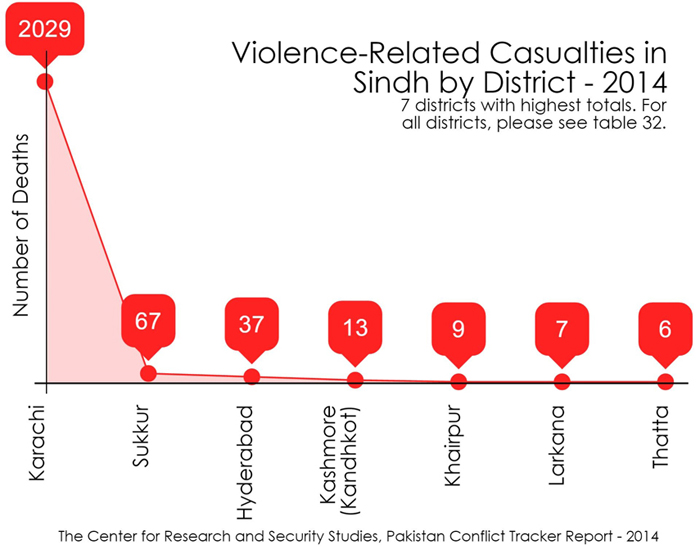
The most common form of violence in Sindh is target killing and 60% of the total fatalities in the province fall into this category. All in all 1,264 persons were the victims of this violence in Sindh and 1,197 of them were from Karachi alone. Last year, target killing had caused 1,628 fatalities in Karachi and it was 80% of the total fatalities in the city. Compared to last year it is nearly a 25% reduction in this category, and may be attributed to the ongoing security operation in the city.
Table 33: Target Killing Comparison of Karachi with Rest of Pakistan – 2014:
| Target Killings Comparison – 2014 | |||
| Month | Karachi | Rest of Pakistan | Pakistan (Total) |
| January | 124 | 123 | 247 |
| February | 119 | 84 | 203 |
| March | 118 | 80 | 198 |
| April | 109 | 93 | 202 |
| May | 114 | 98 | 212 |
| June | 111 | 69 | 180 |
| July | 91 | 59 | 150 |
| August | 132 | 85 | 216 |
| September | 107 | 64 | 172 |
| October | 66 | 55 | 121 |
| November | 61 | 61 | 122 |
| December | 45 | 59 | 104 |
| Total | 1197 | 930 | 2127 |
Graph 33: Target Killing Comparison of Karachi with Rest of Pakistan – 2014:
Table 34: Victims of Violence in Sindh – 2014:
| Victims of Violence in Sindh | |
| Victims | Fatalities |
| Civilians | 1023 |
| Criminals | 484 |
| Militants | 227 |
| Security Officials | 208 |
| Political Party Activists | 133 |
| Religious Party Activists | 74 |
| Religious Persons | 21 |
| Religious Places | 9 |
| Government Officials | 5 |
| Media persons | 5 |
| Foreigners | 4 |
| Total | 2193 |
Sectarian Violence in Pakistan
Sectarian violence resulted in 440 deaths and 478 injured in 2014. The trend of sectarian violence shows a decline (although in 2015, this trend has categorically reversed). Sindh suffered 230 deaths, (52% of the total) from this form of violence, while the second highest number of sectarian-related fatalities was recorded in Baluchistan.
Table 35: Sectarian Violence in Pakistan by Month – 2014:
| Sectarian Violence in Pakistan – 2014 | ||
| Month | Dead | Injured |
| January | 59 | 143 |
| February | 36 | 14 |
| March | 22 | 7 |
| April | 41 | 5 |
| May | 37 | 12 |
| June | 51 | 124 |
| July | 54 | 22 |
| August | 34 | 10 |
| September | 31 | 8 |
| October | 44 | 79 |
| November | 17 | 49 |
| December | 14 | 5 |
| Total | 440 | 478 |
Graph 35: Sectarian violence in Pakistan by month – 2014:
Table 36: Sectarian Violence in Pakistan by Region – 2014:
| Sectarian Violence in Pakistan – 2014 | ||
| Region | Dead | Injured |
| Sindh | 230 | 68 |
| Baluchistan | 86 | 153 |
| KP | 60 | 104 |
| FATA | 35 | 31 |
| Punjab | 23 | 24 |
| Islamabad | 6 | 98 |
| Total | 440 | 478 |
The highest number of fatalities were from Shia and Shia Hazara communities (over 50%). Sunni victims were 30% of the total. Non-Muslim communities were also victim of sectarian violence including Sikhs, Hindus, and Christians.
Table 37: Religion/Sect of Victims of Sectarian Violence in Pakistan – 2014:
| Religion/Sect of Victims of Sectarian Violence in Pakistan | |
| Religion/Sect | Fatalities |
| Shia | 188 |
| Sunni | 142 |
| Shia Hazara | 35 |
| Unk | 30 |
| Sufi | 19 |
| Ahmadi | 8 |
| Hindu | 6 |
| Zikri | 6 |
| Sikh | 3 |
| Bohra | 1 |
| Christian | 1 |
| Ismaili | 1 |
Graph 37: Religion/Sect of Victims of Sectarian Violence in Pakistan – 2014:
Not only were the communities of other religious sect victim of violence the holy places of all faiths were also desecrated in the country. All in all 34 holy places were desecrated in the country last year.
Table 38: Desecration of Holy Places by Region – 2014:
| Desecration of Holy Places by Region | |
| Region | Desecrations |
| Sindh | 12 |
| KP | 12 |
| Baluchistan | 5 |
| FATA | 3 |
| Punjab | 1 |
| Islamabad | 1 |
| Total | 34 |
Table 39: Desecration of Holy Places by Type – 2014:
| Desecration of Holy Places by Type | |
| Type of Holy Place | Desecrations |
| Mosque | 12 |
| Sufi Shrine | 8 |
| Mandir | 6 |
| Imambargah | 3 |
| Ahmadi | 1 |
| Madrassa (Seminary) | 2 |
| Police Station Mosque | 1 |
| Tableeghi Center | 1 |
| Total | 34 |
Conclusion
The year 2014 was witness to many changes and overtures in the conflict scenarios of the country. The armed forces of the country launched a full-scale operation against militant elements mid-year, resulting in an escalation of the number of fatalities from 5,687 in 2013 to 7,650 in 2014. However, it bears stating that militants and criminals face the consequences of their unending lawlessness in their own language. The total number of fatalities of the outlaws went up from 1,346 in 2013 to 4,026 in 2014. It was an unprecedented upsurge resulting in 51% of all fatalities in 2014 compared to 19% in 2013. On the other hand, the fatalities of civilians and security officials went down from 4,341 in the last year to 3,630 this year.
Table 40: Comparative Analysis of Fatalities in Pakistan – 2013 vs. 2014:
| Comparative Analysis of Fatalities | ||
| Fatalities of militants/criminals | 2013 | 2014 |
| Security Operation | 809 | 3370 |
| Drone Attacks | 169 | 209 |
| Infighting – TTP | 259 | 77 |
| Others | 109 | 369 |
| Total | 1346 | 4025 |
| Percentage of total fatalities | 19% | 51% |
| Fatalities of civilians/security officials | 2013 | 2014 |
| Target Killings | 2367 | 2127 |
| Militant Attacks | 1165 | 982 |
| Terrorism | 809 | 516 |
| Total | 4341 | 3625 |
| Percentage of total fatalities | 81% | 49% |
Graph 40: Comparative analysis of fatalities in Pakistan – 2013 vs. 2014:
The being said, the nature of militancy and sectarian hatred remained unchanged in the country. The massacre of school children and killing of innocent people on sectarian grounds are ample examples. Even polio workers and guards, striving strenuously to prevent our children from being crippled, were among the victims of militancy in the country last year. Sectarian violence affected all Muslim and non-Muslim communities. Several hundred political and religious party activists were sent to their graves on political and sectarian grounds.
The resulting situation may have caused the public to take the law into their own hands, resulting in the lynching of 20 alleged criminals. This shows that the cancer of violence has spread to every region of the country and various forms of violence are creating an unsafe and lawless environment.
These events and corresponding data are documented in this report with the hope that those in power may find them useful in reshaping policies, reformulating priorities, and restructuring the state’s response to violence, especially in the wake of the National Action Plan.
_______________________________________________________________________
[1] Killers of children are ‘Kharijites’: Hafiz Saeed, The News, December 23, 2014, http://www.thenews.com.pk/Todays-News-13-34854-Killers-of-children-are-Kharijites-Hafiz-Saeed, retrieved January 20, 2015
[2] JUI-S chief terms school attack ‘a conspiracy’, The News, December 28, 2014, http://www.thenews.com.pk/Todays-News-2-292810-JUI-S-chief-terms-school-attack-a-conspiracy, retrieved January 20, 2015
[3] Militant attacks include suicide attacks, armed attacks, hurling of hand grenades, and indiscriminate firing.
[4] Terrorism includes bomb explosions, IED explosions, and landmines.
[5] Target killings include gunning down a targeted person or dumping of a dead body after abducting a specific person and killing him/her intentionally.
[6] Judge, 10 others killed in Islamabad blasts, firing, Dawn, http://www.dawn.com/news/1090737/judge-10-others-killed-in-islamabad-blasts-firing, retrieved January 28, 2015
[7] Militants storm check posts in Bajaur from Afghanistan, four soldiers killed, The News, http://www.thenews.com.pk/Todays-News-13-30746-Militants-storm-checkposts-in-Bajaur-from-Afghanistan-Four-soldiers-killed, retrieved January 28, 2015
[8] Ibid
[9] Ibid
[10] Levies post stormed, weapons looted, Dawn, http://www.dawn.com/news/1117577/levies-post-stormed-weapons-looted, retrieved January 28, 2015
[11] Three killed in militant attack on Bajaur checkpost, sources, Dawn, http://www.dawn.com/news/1118780/three-killed-in-militant-attack-on-bajaur-check-post-sources, retrieved January 28, 2015
[12] Thwarted attack: 12 militants killed in 11-hour gunfight at Quetta airbases, Express Tribune, http://tribune.com.pk/story/749377/thwarted-attack-12-militants-killed-in-11-hour-gunfight-at-quetta-airbases/, retrieved January 28, 2015
[13] Soldier dies in cross-border attack in Baluchistan, The News, http://www.thenews.com.pk/Todays-News-13-32384-Soldier-dies-in-cross-border-attack-in-Balochistan, retrieved January 28, 2015
[14] Terror strike: Pakistan Navy foils attack on Karachi dockyard, Express Tribune, http://tribune.com.pk/story/759826/terror-strike-pakistan-navy-foils-attack-on-karachi-dockyard/, retrieved January 28, 2015
[15] Briefs…, The News, http://www.thenews.com.pk/Todays-News-2-273308-Briefs, retrieved January 28, 2015
[16] Four soldiers, 20 militants killed, The News, http://www.thenews.com.pk/Todays-News-13-32941-Four-soldiers-20-militants-killed, retrieved January 28, 2015
[17] 17 militants killed as attack repulsed in Bara, The News, http://www.thenews.com.pk/Todays-News-13-33987-17-militants-killed-as-attack-repulsed-in-Bara, retrieved January 28, 2015
[18] 2 FC men, 15 militants killed in Orakzai check post attack, Express Tribune, http://tribune.com.pk/story/789154/2-security-officials-15-militants-killed-in-orakzai-check-post-attack/, retrieved January 28, 2015
[19] Terror jolts Pakistan, The News, http://www.thenews.com.pk/Todays-News-13-34723-Terror-jolts-Pakistan, retrieved January 28, 2015
[20] 25 terrorists killed in SWA clash, The News, http://www.thenews.com.pk/Todays-News-13-34824-25-terrorists-killed-in-SWA-clash, retrieved January 28, 2015
[21] Surgical strikes: Army helicopters support strike against Zanglani gang, Express Tribune, http://tribune.com.pk/story/728911/surgical-strikes-army-helicopters-support-strike-against-zanglani-gang/, retrieved January 28, 2015
[22] 10 militants killed in operation on Panjgur-Awaran border, The News, http://www.thenews.com.pk/Todays-News-13-30154-10-militants-killed-in-operation-on-Panjgur-Awaran-border, retrieved January 28, 2015
[23] Nine killed as gunships strike militant hideouts in Hangu, Dawn, http://www.dawn.com/news/1088731/helicopter-shelling-kills-six-militants-in-hangu, retrieved January 28, 2015
[24] 3 suspected militants killed in shelling, Express Tribune, http://tribune.com.pk/story/676846/3-suspected-militants-killed-in-shelling/, retrieved January 28, 2015
[25] Aerial shelling: Copters pound militants’ hideouts in FR Peshawar, Express Tribune, http://tribune.com.pk/story/696237/aerial-shelling-copters-pound-militants-hideouts-in-fr-peshawar/, retrieved January 28, 2015
[26] ‘Reprisal’ attack: Blast kills 13 police commandos, Express Tribune, http://tribune.com.pk/story/671588/reprisal-attack-blast-kills-13-police-commandos/, retrieved January 28, 2015
[27] Hospital attacked: Blast destroys EPI office, dental block, Express Tribune, http://tribune.com.pk/story/662966/hospital-attacked-blast-destroys-epi-office-dental-block/, retrieved January 28, 2015
[28] Four killed, 50 rounded up in Swabi raid, Dawn, http://www.dawn.com/news/1084221/four-militants-killed-in-swabi-raid, retrieved January 28, 2015
[29] Triple explosions kill 13 in Peshawar cinema, The News, http://www.thenews.com.pk/Todays-News-13-28516-Triple-explosions-kill-13-in-Peshawar-cinema, retrieved January 28, 2015
[30] Taliban claim killing of 23 FC men, The News, http://www.thenews.com.pk/Todays-News-13-28610-Taliban-claim-killing-of-23-FC-men, retrieved January 28, 2015


